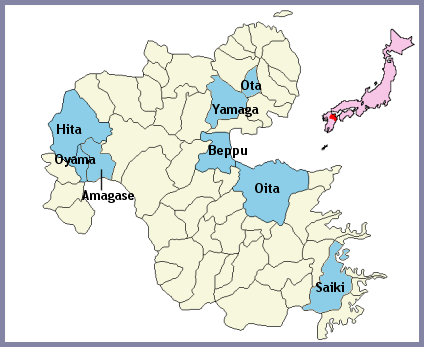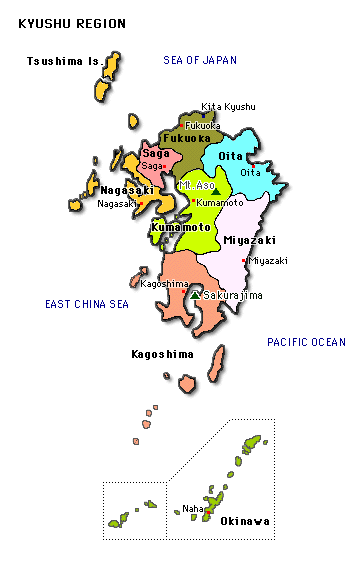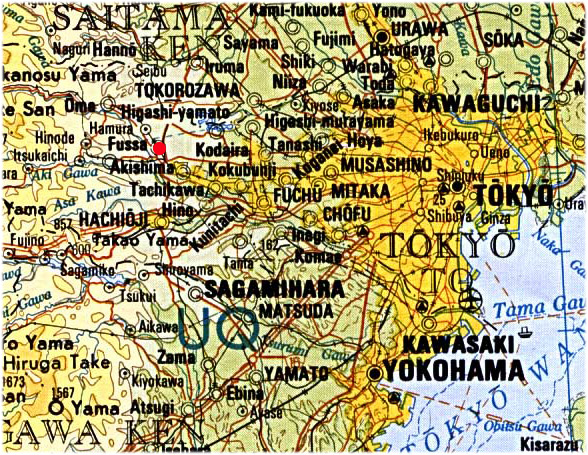

New stories found on the internet about the orphanage in Beppu. As you can see
from the maps above, you will see Oita City where I was born, and Beppu, where
the orphanage is located.
Stars and Stripes - December 28, 1960 Army hikers covered 826 miles for orphans By Staff Sgt. Frank Ermence Stars and Stripes Southern Japan Bureau BEPPU, Japan - Two hikers of the U.S. Army Transportation Agency, Japan, completed their 826-mile trek from Zama to Beppu Tuesday. Both of them agreed they wanted plenty of rest. Capt. John O. Arnn, 38, of Carmel, Calif., and SP4 Jimmie C. Dexter, 19, of Dallas, Texas, covered the distance in 13 days, 14 hours and 44 minutes. They began walking Dec. 14 and arrived at the Beppu railroad station at 2:15 p.m. The soldiers upset an official welcome by arriving 15 minutes earlier than planned, even though they deliberately slowed their pace during the last few miles. Arnn, a former member of the 187th Airborne Regimental Combat Team when it was stationed at Beppu, suggested the hike to raise funds for a new dormitory in the Garden of Light orphanage here, and Dexter accompanied him. They raised funds through donations along the way. Many Japanese welcoming the soldiers expected them to walk to the orphanage entrance, but their goal was the Beppu station. They were taken by car from the station to the orphanage, where they were greeted by more than 50 children who live there. "Right now I wouldn't say if I want to make this trip again," Arnn told reporters. "I just want a hot bath and a good meal." "We've been cold for the past two weeks," Dexter said during a short rest before walking the final seven miles to Beppu. "We walked all Monday in order to arrive near the scheduled time." Both had blisters on their feet. Dexter had one on his left heel and Arnn's right heel was slightly infected. Arnn said they covered 65 miles on their best day. The soldiers said they spent most of the nights in Japanese hotels but slept along the road three of the 14 nights. They said one of their biggest welcomes was at the Marine Corps Air Facility at Iwakuni, where the Marines met them on the highway and took them to the facility for a steak dinner. They said the weather was mostly clear and cold, but on three days they encountered snow and rain. Arnn was to leave Beppu Wednesday for Itazuke AB to catch a flight back to Tokyo. Dexter returned to Zama Tuesday in an Army L-20 liaison plane from Itazuke. Last August, Marine Sgt. Howard Bentz and PFC Ervin Blackburn, covered 840 miles in 17 days, 4 hours and 23 minutes from Sasebo to Tokyo to raise $1,000 for Japanese orphans.
Saturday, September 30, 2000
Recreation of famed Beppu
trek will benefit orphanage
By Richard Roesler
Tokyo bureau chief
TOKYO — On Dec. 15, 1960, one minute past midnight, a U.S. Army captain and a specialist shouldered their 40-pound rucksacks and headed into the night.
Their goal: an orphanage in the Kyushu city of Beppu, 826 miles southwest.
They were trying to beat a long-distance hiking record of two Marines, who’d covered about the same distance in 17 days several months earlier. The two soldiers had bet their friends that they could beat that time. The winner would be the orphanage, which stood to gain about $10,000 in bets and pledges for a new building.
The GIs made the trip in 13 days, and the orphanage got their money.
So when the orphanage needed money to rebuild the home this year, they decided to try the same thing.
On Sept. 17, a handful of Japanese marathon runners and an American Army lieutenant started a relay race that re-creates the two GIs’ route from 40 years ago. The run, which started at Sagamihara Housing Area, near Camp Zama, is expected to end with a ceremony Saturday at the orphanage, said Zama’s Maj. Steve Boylan.
"Right now, 28 runners are on their way to Beppu," said the orphanage’s Seiji Yano, who helped organize the run. "We’re asking each to contribute 10 yen per kilometer they run. Our goal is 2.5 million yen."
The 1960 trek was the brainchild of Capt. John Arnn. The Arizona cowboy turned enlisted man during World War II, going to work after the war in western lumber camps. When the Korean War broke out in 1950, he re-joined as an officer, and saw combat as a paratrooper.
After the war, he was assigned to Japan, at an Army camp near Beppu.
The war and subsequent poverty in Japan left thousands of children orphaned and homeless, sleeping by the roadside or in train stations. In Beppu, a woman named Shige Nagata started taking these children in, letting them live in her shack. She named her home the Garden of Light.
The U.S. occupation troops at the nearby camp, including Arnn, helped support the children’s home.
He stayed in touch with the orphanage after he was transferred stateside in the mid-1950s, at one point sending them $500, much of it borrowed, to do some repairs. In 1960, he was stationed back in Japan, at Camp Zama, near Tokyo. The walk started as an effort to raise money so the children could live under a roof that didn’t leak all the time.
Arnn’s interest in orphans may have been partly motivated by a sense of personal atonement. In the early 1990s, a Camp Zama sixth-grader named Janice Frew wrote a booklet about Arnn, interviewing several of his old friends and family in the process. She was told that Arnn had accidentally killed a Korean couple during that war, leaving their child an orphan. There’s no way to confirm this with Arnn; he was killed on Christmas Eve, 1966, when a land mine exploded under his jeep in his third war zone: Vietnam. He was a major at the time of his death.
What is known is that Arnn, then 37, and 19-year-old Spec. Jimmie Dexter did, in fact, make the trek from Zama to Beppu. Stripes covered their trek along the way, including their blistered heels and Arnn’s two sprained ankles. They covered 60 miles the first day, including a 15-mile uphill hike near Hakone.
They averaged 65 miles a day, with about 3 hours of sleep a night. It rained and snowed on them several times. Each carried $50 in spending money to stay at Japanese inns along the way, but three of the nights they spent asleep by the roadside.
"The Japanese along the route are just wonderful," Arnn told Stripes a week into the trip. "They don’t accept any money for food. I’ve never eaten so many tangerines and drank so much milk in all my life."
There were a few relaxed moments. Japan National Railways put them up in a hotel, where they got a comparatively luxurious seven hours’ sleep. And when they neared the Marine Corps Air Station at Iwakuni, the Marines met them on the road and hauled them in for a steak dinner.
Then the two continued on.
"We will spend Christmas Eve walking," Arnn told Stripes on Dec. 23. "We have no special plans for Christmas, but if we pass a church, we want to spend a few minutes inside." Three days later, the men walked all night in order to arrive at the time they’d predicted.
Finally, on Dec. 27, the two arrived at the orphanage, where they were swamped with cheering kids. The city of Beppu, moved by the GIs’ efforts, donated thousands of dollars more.
Arnn ended up making the walk twice more in the following two years, and a large dormitory complex was completed in late 1964, barely a year before Arnn was killed. The facility is called the Dormitory of the White Chrysanthemum.
Arnn’s life was later made into a Japanese movie, The Walking Major, starring Frank Sinatra Jr. and the Japanese actor Yujiro Ishihara, whose brother Shintaro is now the governor of Tokyo.
To kick off this year’s run, the orphanage showed the movie Sept. 16 at Sagmihara Housing Area’s theater, as part of a reception for the runners, organizers and sponsors, which include a running shoe company and Japanese automaker Nissan.
The orphanage "wanted to show the people involved with the marathon what kind of person John was," said Scott Oestringer, with Zama’s 17th Area Support Group. The reception was held at the nearby John O. Arnn Elementary School, which was named in 1982.
"It felt good," said Oestringer, who helped with the arrangements, "when you’re able to support the Japanese in such a way, to help remember one of our own guys."
Mayumi Yamamoto, Hiroshi Chida and Norio Muroi contributed to this report.
A LOOK BACK: Stripes' coverage of the 1960 hikers' arrival at Beppu.
They made a movie with Dale Robertson as the Major who actually walked from Camp Zama to Beppu. I can't find the movie to purchase.
Aru heishi no kake
THE WALKING MAJOR
year unknown
Dale Robertson.................Major Allen
"The Walking Major" is a true story about Major Allen, who bet all the servicemen around the world that he could walk the 800 miles from Tokyo, Japan to Beppu in under two weeks while carrying a full pack. All the money which was won would be used to build an orphanage in Beppu.
Major Allen won the bet, covering the 800 miles in 13 days and about 20 hours.
This film was made in Japan. It won all the foreign picture film awards.
Look for the red circle, this is Fussa-Shi, the town where I lived while stationed in Japan.
